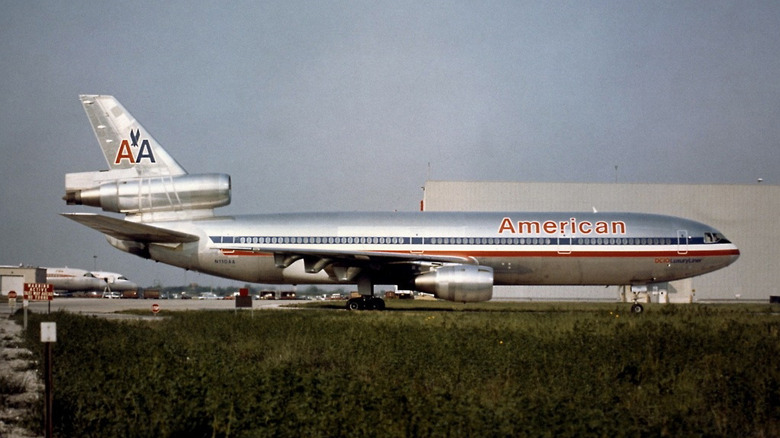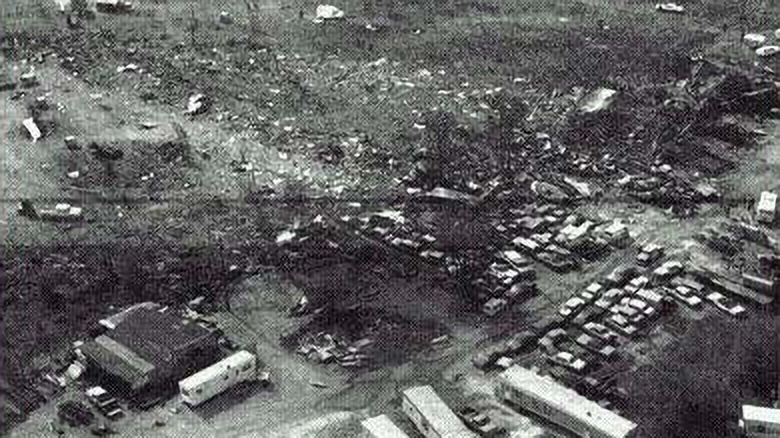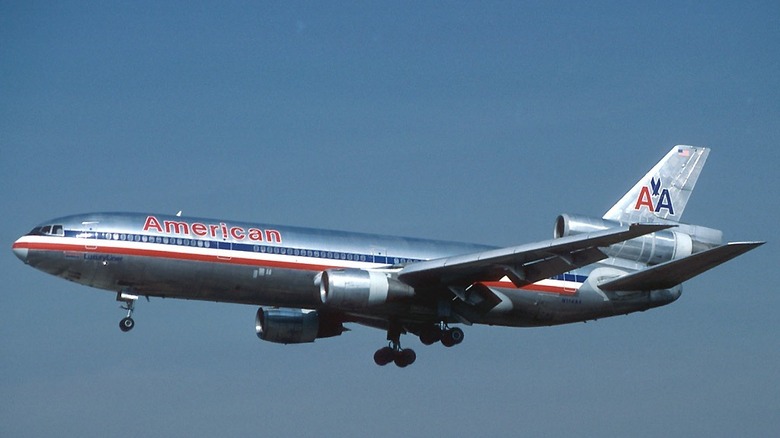What Was The Worst Accident In US Aviation History? (And What Caused It?)
The recently solved Hindenburg mystery is often the first event to pop up in discussions about the worst aviation disasters, partly because of the iconic newsreel footage of the 1937 accident in Lakehurst, New Jersey. The Air Force's deadliest crash came in 1952, and the worst commercial airline accident in the United States came in the late '70s when American Airlines Flight 191 crashed near O'Hare International Airport in Chicago, killing nearly 300 people. On May 25, 1979, the three-engined McDonnell Douglas DC-10 pictured above took off from O'Hare on its way to Los Angeles. After a flight that lasted just 31 seconds, the jet lost control, collided with a building, and crashed in a field. The impact and resulting fire killed the 258 passengers and 13 crew members aboard, along with two people on the ground. During takeoff, the left engine broke loose, flipped over the wing, and fell to the runway. Captain Walter Lux and First Officer James Dillard tried to climb with the remaining two engines, but hydraulic lines had been severed and the wing and important instruments were damaged.
Despite their best efforts, the left wing failed, making it impossible to achieve the lift symmetry required for a stable flight. Without proper thrust or aerodynamics, the plane quickly went out of control, cartwheeled into a building, and crashed into a nearby field and mobile home park. Following a lengthy investigation, the National Transportation Safety Board (NTSB) released a detailed 103-page report, identifying "asymmetrical stall" and "roll of the aircraft" as the probable cause of the crash. The report also blamed the failure of the engine pylon attachment points, which had been damaged during earlier maintenance. After the accident came loads of legal and business troubles for American Airlines and McDonnell-Douglas, including a lawsuit filed by families of the victims seeking compensation for their loss.
What caused the AA flight 191 crash?
The disaster unfolded across multiple stages, but flight 191 got off to a bad start. "During takeoff rotation, the left engine and strut assembly separated from the wing, and traveled over the wing, severing hydraulic lines in the associated area of the wing," notes the official Federal Aviation Administration (FAA) log. This resulted in a cascade of failures affecting the slat position sensing kit, stick shaker motor, electrical power generator, warning lights, and emergency warning computer kit. Additionally, the lack of any cross-communication between warning systems linked to the other engines worsened the problem further.
Moreover, the hydraulic system lacked a backup mechanism that would allow the crew to operate the wing flaps in the event of a hydraulic system failure. The pilots were initially able to keep the plane under control as it took flight. But after reaching an altitude of around 300 feet, the plane began losing speed and rolling to the left, eventually losing control and crashing. In reality, the engine pylon had been damaged months earlier by a forklift operator during an engine swap. "In retrospect, it produced an unforeseen, difficult to detect problem that damaged the airplane and led directly to the crash," read the FAA report.
DC-10s were involved in many 1970s incidents
Over the years, the McDonnell Douglas DC-10 airplane built up an unsavory reputation, earning nicknames like the "Death Cruiser" and "Donald's Disaster." The DC-10 was grounded for a short time less than a week after the Chicago crash, but was ultimately involved in more than 50 incidents before the last one flew commercially about a decade ago. In 1972, the rear cargo door blew out on a DC-10 bound from Los Angeles to New York, causing a massive decompression event. Parts of the floor were damaged, severing critical control cables and knocking out an engine. Thankfully, Captain Bryce McCormick pulled off a heroic rescue and managed to land it safely using the manual throttle system. An inquiry was immediately ordered and safety regulations were tightened, but that wasn't enough. Two years later, a DC-10 jet ferrying passengers from Paris to London aboard Turkish Airlines Flight 981 crashed about 10 minutes after takeoff. At an altitude of approximately 11,000 feet, this plane experienced a similar failure of the cargo door, leading to rapid depressurization and damage to the floor.
Six passengers were ejected during the perilous descent, which also saw an engine fail and the flight control system sustain heavy damage. The plane crashed in a forest just 77 seconds after the door mishap, resulting in the death of all 346 people aboard the flight. On Halloween of 1979 — barely five months after the flight 191 disaster — a DC-10 operated by Western Airlines crashed on a runway in Mexico City, killing 63 passengers, nine crew members, and one person on the ground. Western Flight 605 had attempted to land on a closed runway, hit a cargo truck, crashed into a service building, and triggered a fire and an explosion. This crash was attributed to miscommunication among cockpit crew and air traffic controllers, unlike earlier incidents which were caused by engineering failures or prior damage.


